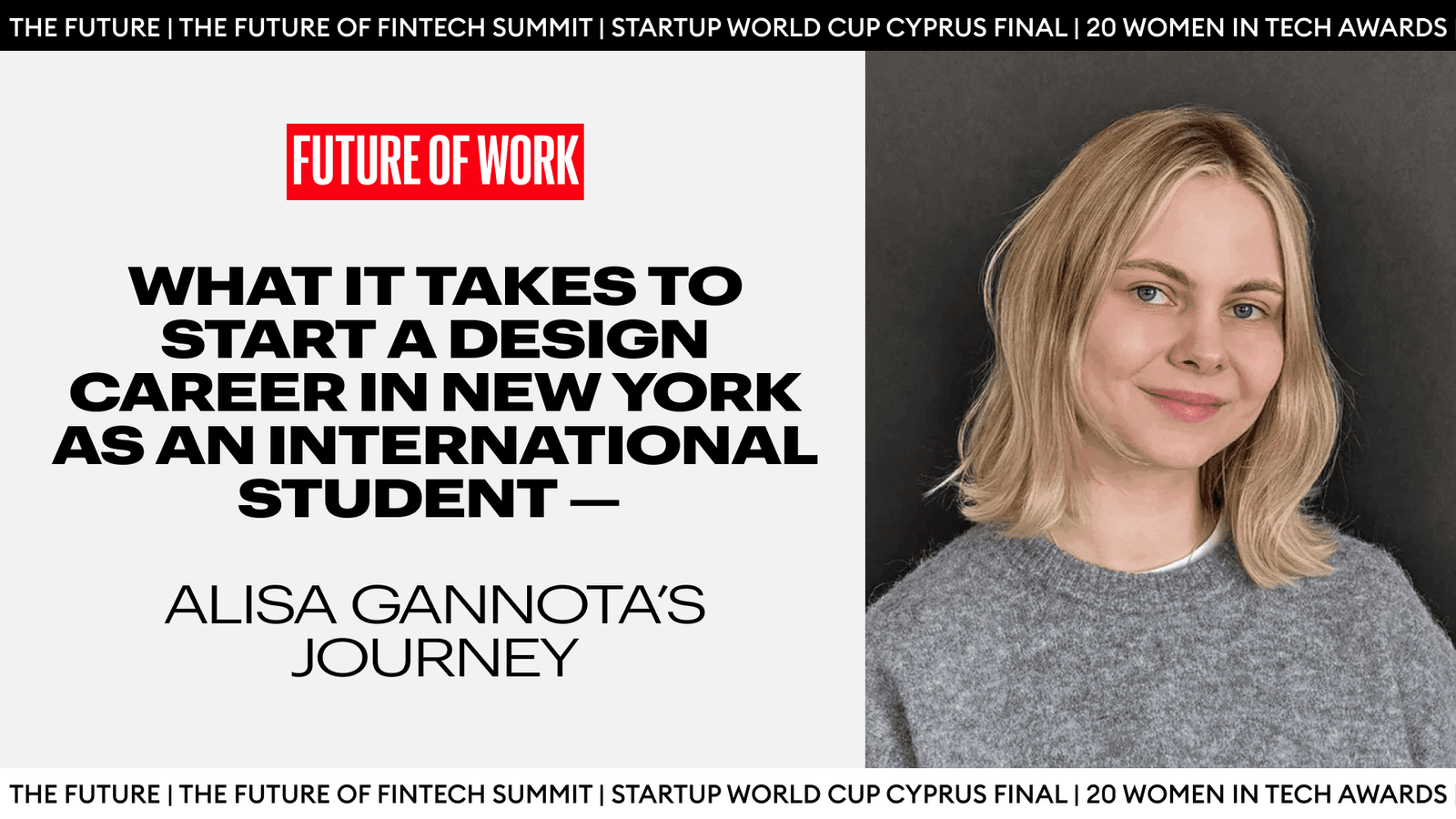Breaking into the U.S. design industry is hard. Doing it on a student visa is even harder. International students account for just 12% of design graduates in the U.S., but nearly 70% of them are denied work visas in creative fields. Alisa Gannota knew the odds. But when she was accepted to Parsons School of Design with a scholarship offer, she saw it as a rare chance to get closer to the industry she hoped to join.
Now 24 and based in New York City, the Belarusian-born designer has steadily built a career in one of the world’s most competitive creative markets. From early freelance projects to her current role at global branding agency JDO, she’s navigated not just the usual industry challenges, tight deadlines, fast turnarounds, creative pressure, but also the added weight of visa deadlines and the financial strain of living in one of the top three most expensive cities in the world.
Follow THE FUTURE on LinkedIn, Facebook, Instagram, X and Telegram
In this interview, she talks openly about studying and working in the U.S., the pressures of breaking into the design field as a non-citizen, and what it takes to find your place and your voice in one of the world’s most competitive creative cities.
Can you tell me a bit about where you’re from and what first drew you to design?
I’m Alisa Gannota, a graphic designer based in New York City, originally from Belarus. I started out exploring creative fields through drawing, painting, and sculpture, trying out just about anything visual. That early love for art evolved into a broader interest in how visuals shape meaning, which naturally led me to design.
I found it to be the perfect blend of my creative background and my desire for structured problem-solving. What I love most is the ability to build visual systems that not only look great but also communicate a deeper brand story and bring abstract ideas to life in a strategic way.
What made you decide to study in New York?
New York was always on my radar because of its creative energy and professional opportunities. It’s home to many of the world’s top design studios and global brands, and the industry here moves fast—it’s experimental, diverse, and always evolving. I was excited by that pace and the idea of working in a place where fresh ideas are constantly being generated.
I chose Parsons School of Design because of its strong reputation and the structure of its program. The school prioritizes concept development and critical thinking just as much as craft. Many of the faculty members are also active professionals, which offers invaluable insight into the current design landscape. That connection between the classroom and the real world helped me build confidence early on and develop both a creative and strategic lens.
What were some of the biggest cultural or financial challenges you faced moving to the U.S.?
Adjusting to life in New York came with its own learning curve. For one, it’s incredibly expensive. Even small things like grabbing lunch on campus could easily cost $15 or more. The housing situation is intense; most people have roommates well into their thirties, and personal space is limited.
You also notice how transient the city can be. People move homes, jobs, and routines frequently. Culturally, the work-life balance is very different from what I was used to. The pace is relentless, especially in creative fields, and you’re constantly expected to push harder and faster. That can feel overwhelming at first, but over time, I learned to adapt and found ways to maintain a bit of balance while staying competitive in such a dynamic market.
How would you describe the experience of studying design in New York? What surprised you most?
Studying design in New York was both intense and rewarding. One of the biggest surprises was how much emphasis was placed on thinking, not just doing. At Parsons, we were constantly asked to explain our thought process, reference our influences, and build narratives around our work. It wasn’t just about making something look good—it had to mean something, serve a purpose, and be backed by a clear strategy.
The first-year foundation program also stood out. It’s modeled on the Bauhaus tradition and encourages exploration across different artistic disciplines. That experience taught me to embrace new mediums, experiment outside of my comfort zone, and develop a broader, more holistic approach to design thinking. It gave me the freedom to fail — and to grow.
Can you break down the real cost—tuition, living expenses, and other fees? How did you manage it?
I was fortunate to receive a talent-based scholarship from Parsons, which made a huge difference. But the actual cost of studying in New York City, between tuition, rent, food, and materials, is steep and can easily reach $100,000 a year.
That said, most schools, even for international students, offer merit-based or need-based aid, so it’s always worth applying.
Looking back, was the investment in your education worth it?
Yes. Beyond the education, being part of the industry early and building long-term connections, especially with classmates, has opened up so many doors. A lot of opportunities come through recommendation and word of mouth, so just being in the room helps a lot.
Attending a school like Parsons also gave me direct access to the industry through internships, visiting professionals, and industry events. It really helped me understand the real-world expectations of the design world.
How did you land your first job in design after school, and what helped you stand out?
Getting that first job was tough, especially as an international student. A lot of companies hesitate the moment they hear about your visa status, which is frustrating but unfortunately common. The key is to stay persistent and not let that discourage you.
I focused heavily on making my portfolio clear, thoughtful, and well-structured. Each project was presented as a case study, showing not just the final outcome but the strategy, research, and decision-making that led there. I made sure to demonstrate how I think as a designer.
In interviews, I emphasized process over polish, and I think that helped me stand out. It showed that I could not only execute but also contribute creatively and strategically.
Can you share your experience working with the leading agency, JDO Global?
JDO Global was actually my first role in the industry. I started off freelancing, which gave me a chance to build confidence and gain hands-on experience with real clients. That led to an internship, and eventually a full-time position.
Being part of a studio like JDO was a great early experience because it exposed me to a wide range of project types, from packaging and campaigns to full brand identities. The fast pace and high expectations pushed me to level up quickly, and I learned how to balance creativity with clear, strategic thinking.
Have you faced any unique challenges as a woman in the design/tech space?
Yes, though it varies depending on the company and team. Gender bias still exists, even in progressive cities like New York, but I’ve also been lucky to work with people who genuinely value diverse perspectives. Having supportive mentors and strong female leaders around makes a big difference.
What’s the salary range someone in your position might expect in New York?
Entry-level salaries can vary widely depending on the agency or type of design work you do. For junior designers, it typically falls between $45,000 to $65,000. It’s on the lower end, considering the cost of living in New York, but it’s part of getting your foot in the door.
As you gain more experience, the range expands, especially if you build a strong portfolio and position yourself as a thinker, not just a maker. Freelance and contract work can also offer more flexibility and potential for higher income once you’re more established.
What does your life look like now in terms of financial independence, career freedom, or creative fulfillment?
It’s still a work in progress. The design industry can be unpredictable; it’s often project to project, so financial stability comes with time. But I genuinely love what I do.
Right now, I’m focused on gaining as much experience as possible and building a strong portfolio. Working at a design agency means I get to jump between different types of projects like campaigns, packaging, and branding, which keeps things exciting. Freelancing on the side lets me choose more experimental or fun projects, and those often come with more creative freedom and trust from clients.













